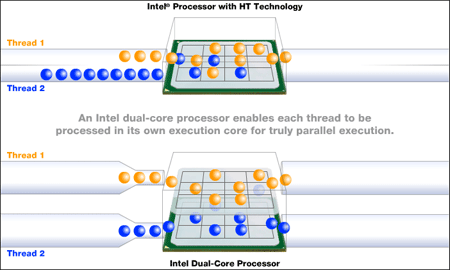Pentium D 820 and i945G/P Chipset Showcase
In recent months, the race between the two major industry playersto bring dual-core processing to the masses has heated up. On April 4th, Intel delivered its first dual-core Pentium offering in the form of the Intel Pentium Extreme Edition 840. AMD was soon to follow, on May 9th, releasing its dual-core Athlon 64 X2 4800+.
While Intel may have been first to deliver a dual-core processor for the masses, AMD's updated X2 processor architecture brought with it the path of least resistance by supporting existing socket 939-based hardware. In fact, AMD's dual-core Athlon 64 X2 requires only a simple BIOS update to support the new processors. Conversely, Intel's new design requires new chipsets to take advantage of its dual-core processor, adding to overall upgrade costs for do-it-yourselfers and another specifically dedicated chipset in the mix for OEMs.
Regardless, today Intel further expands its dual-core Pentium arsenal with the release of the Pentium D 820 and i945G/P chipset. Unlike the high-end i955X Express chipset and Pentium EE 840, these new additions focus more on the mainstream consumer and business-class market. The Pentium D comes in three flavors: the 840 at 3.2GHz, 830 at 3GHz, and the 820 at 2.8GHz. Intel also released two of its own new 945G motherboards to support the Pentium D, in the D945GNT (ATX) and D945GNTP (Micro ATX).
To help us get acquainted with the Pentium D and 945 Chipsets, Intel sent us its latest dual-core processor, the Pentium D 820, along with a D945GTPLR reference motherboard. Running at 2.8GHz, the Pentium D 820 is equipped with dual-processor cores but doesn't support Hyper-Threading, while the D945GTPLR brings new features along with an updated integrated graphics controller. In the pages ahead, we'll go over the finer points of each product in more detail and take a look at the performance profile each brings to the table. First, let's take a quick look at the major features of both the Intel Pentium D 820 and D945GTPLR reference board.
|
|
|
Codenamed "SmithField," the Pentium D is very similar to the Pentium Extreme Edition 840 in many ways. Like the EE 840, the Pentium D sports two execution cores, each equipped with 1MB of L2 cache (2MB Total). The Pentium D also supports Intel Extended Memory 64 Technology for 64-Bit computing, as well as Execute Disable Bit for added security features against certain virus attacks. The main difference between the Pentium EE 840 and the Pentium D is that the Pentium D doesn't support Hyper-Threading technology. Furthermore, the 820 comes in with a lower 95w Thermal Design Power rating. So the Pentium EE 840 holds the top spot as the current fastest dual-core CPU Intel has to offer, while the Pentium D series brings improved multithreaded performance over comparable single-core Pentium 4 processors with Hyper-Threading technology.
As the diagram below demonstrates, with a single-core Pentium 4 with Hyper-Threading, two data threads can be processed across the core at one time in a parallel fashion. This was a major improvement over single-threaded cores, yielding significant performance gains over the earlier designs, especially when multitasking and in multithread-capable applications. With a dual-core Pentium D, however, each core has its own dedicated thread and physical processing resource, significantly improving the efficiency of how workloads are processed.

While the cores reside in a single package, what you essentially have are two distinct processors sharing a common bus. Just like a dual-processor configuration, however, applications need to be coded to take full advantage of both cores simultaneously. Nonetheless, this doesn't mean that two cores are not beneficial with single-threaded applications. One of the dual-core's strengths is its effects on multitasking. For example, it is now much more feasible to encode video while playing a game, working in a word processing application, and browsing the Web simultaneously as each task can be processed in a seperate core. Furthermore, the overall system responsiveness should be improved significantly over single-core processors as system tasks are effectively split between the two cores.
With the Pentium D series processor, Intel brings a more flexible processor to the mainstream consumer. With dual cores and 2MB of L2 cache split between each core, support for 64-bit operating systems, and a complementary new chipset in the i945 series, Intel brings a fairly scalable offering to the table. Next, we'll explore the D945GTPLR system board and the virtues of the i945 chipset in more detail.






